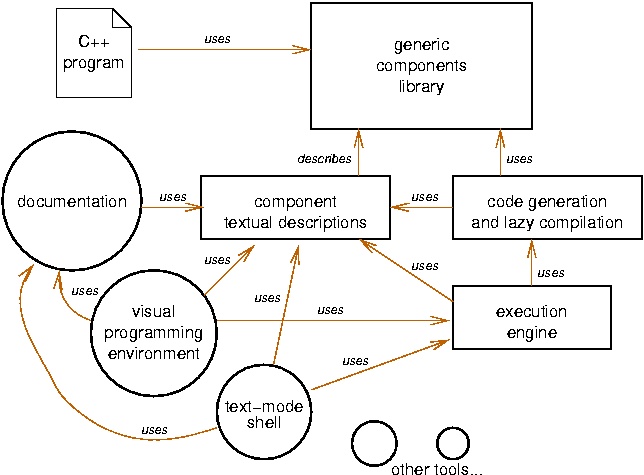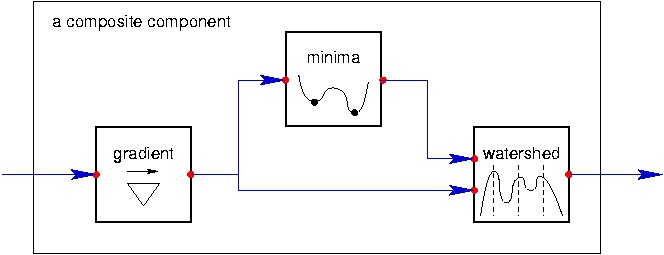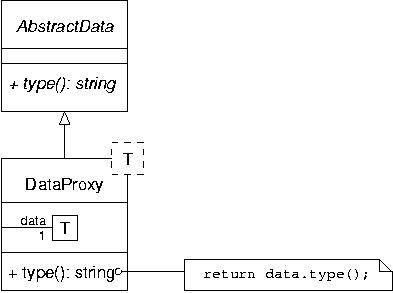
|
Alexandre Duret-Lutz Epita R&D Laboratory 14-16 rue Voltaire 94276 Le Kremlin-Bicêtre France alexandre.duret-lutz@lrde.epita.fr |
This paper presents Olena, a toolkit for programming and designing image processing chains in which each processing is a component. But since there exists many image types (different structures such as 2D images, 3D images or graphs, as well as different value types) the platform has been designed with genericity and reusability in mind: each component is written as a generic C++ procedure, a-la STL.
Other libraries, such as Khoros [Kon94] have a different approach where a processing component contains an implementation for each type supported by the library. This makes code maintenance hard and this prevents easy addition of new image types.
Still, Olena is not only a generic component library [Jaz95], it shall contains additional tools such as a visual programming environment (VPE). Those tools may be programmed in a classical object-oriented fashion (using operation and inclusion polymorphism) which may seems antagonist with the generic programming paradigm used in the library.
Section 2 outlines the architecture of Olena and elaborates more on the designs problems resulting from the use of generic components. Section 3 presents the solution chosen to address these problems.
2 Overview of the platform architecture

Figure 1 shows the various parts of the architecture. A text-mode shell interface is needed to call the components and to prototype a processing, either interactively or via a script. Alternatively, a visual programming environment can be used to define the data flow diagrams for a processing chain. In each of these environment, components can be grouped to form reusable composites components (such as the one shown in figure 2); and once a processing has been successfully prototyped, the corresponding C++ code can optionally be generated.

Moreover, for each component the representation in the environment (visual aspect in the VPE, option switches in the text-mode shell) as well as on-line help shall be generated automatically. These require additional information that is recorded by a database of textual description of each components.
The kernel of the platform is a generic library which provide
generic components and data. A component is a processing, and is
written as a C++ generic procedure. Data are the entities that
transit between components in the processing chain; the library
provides image classes, neighborhoods, value types, histograms,
etc. This library can be used directly by the end user in a
C++ program, independently of the other tools of the platform.
A component that adds a constant value to an image can be written
as follow.
template< class Aggregate_Model >
void add (Aggregate_Model& input, typename Aggregate_Model::data_type value)
{
typename Aggregate_Model::iterator_type iter = input.create_iterator ();
for (iter.first (); !iter.is_done (); iter.next ())
iter.current_item () += value;
}
An issue with generic components is that they lead to many instances (several binary variants). As long as it is used directly in a C++ program this is not a problem because the compiler will determinate and compile only the needed variants. But in interpreted environments such as the VPE, instances needed are not known until run-time. Moreover the number of available image types prevents the compilation of all variants once and for all (anyway since we want to allow the user the adds new types, this would not be a good answer). We detail our solution in the next section. Type constraints on the arguments types are also described for each component, because the interpreted environments will perform type checking at run-time.
3 Technical
Solutions environment
As we said, at the VPE (or any other use interface) level only
abstract data are handled. The only requirement is that in order to
perform type checking, we need a type() method which return the real
type of the data as a string.
The abstract type used is not part of the generic library since it
makes sense only for the VPE. Figure 3 shows how
a set of concrete data types can be grouped in a hierarchy. We
encapsulate each data of type T
in a class DataProxy<T>
which inherit from the superclass
AbstractData. This an application of
the external polymorphism pattern
[Cle96].

AbstractData and
DataProxy classes.
Thus, the VPE can handle abstract data, but in order to apply the
algorithm, the data should be downcast back to its concrete type. If
the set of types is short and fixed, this can be done using a switch construction. Unfortunately
neither conditions are true: there exists a lot of types and the users
can add new ones. Our solution is to use lazy compilation.
Data flow is managed by an Execution Engine Figure 2 ). When all the inputs of a components are ready (i.e. the upstream components have completed their work) the processing can start. But before it begins, several steps must be performed:
As an exemple, consider the "add" component. "add" takes two inputs
- let's label them input1 and
input2 - and produce one output
- named output. If this
component receive a Image2D<Float> object and a Float value as inputs, the following
code will be generated:
void add__Image2D_Float_ (Component& cmp)
{
/* downcast the data */
Image2D<Float> input1& =
static_cast< DataProxy< Image2D< Float > >& >(cmp.entry ("input1")).data;
Float input2& =
static_cast< DataProxy< Float>& > (cmp.entry ("input2")).data;
Image2D<Float> output& =
static_cast< DataProxy< Image2D< Float > >& >(cmp.entry ("output")).data;
/* apply the algorithm */
add (input1, input2, output);
}